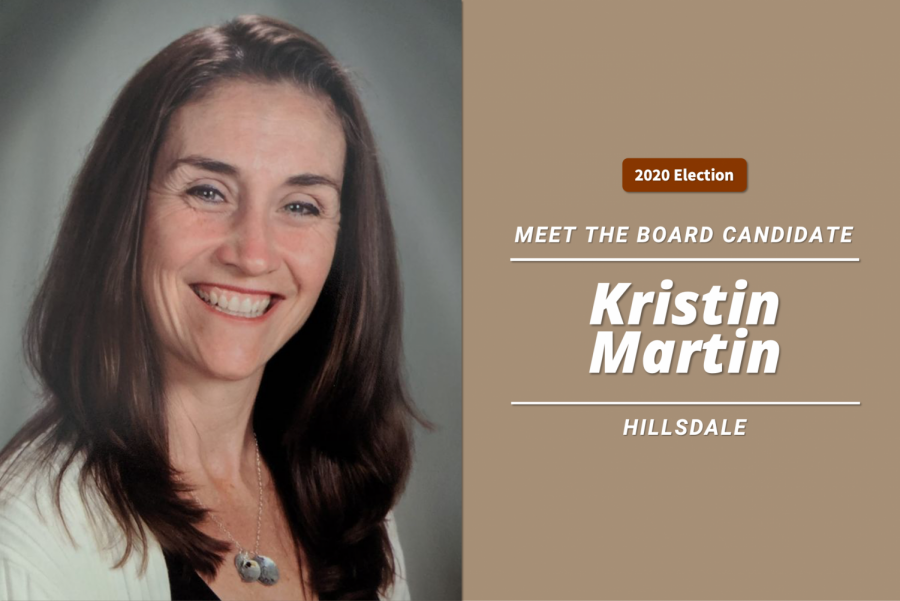
Kristin Martin is running for one of the two open Hillsdale seats. The other candidates running for the two open Hillsdale seats are Arnold Scher (incumbent), Gini Varghese, and Pat Luisi.
Martin grew up in Westwood and has lived in Hillsdale for over 21 years with her husband and two children, both of whom attend Valley. She earned her undergraduate degree from Rutgers University and her Master of Education degree from Montclair State University.
Martin has taught in the Upper Saddle River School District for 22 years. She has also served as a Board member on the Hillsdale Football Association for eight years and coached youth sports in Hillsdale.
Martin has centered her campaign around improving communication between the Board and the community, enhancing student wellness, and maintaining “positive and respectful dialogue.”
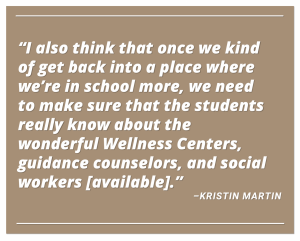 Why Martin is running
Why Martin is running
Martin named two encompassing priorities of hers if elected: student wellness and a greater emphasis on post-graduation opportunities besides college.
“In this new kind of world we’re living in,” Martin said, “wellness has to be at the forefront.”
As a middle school teacher in Upper Saddle River, Martin explained she has noticed “a lot of my students who always presented as strong starting to crumble,” emphasizing the need for raising awareness about the “wonderful Wellness Centers” at Valley as well as “guidance counselors [and] social workers” available to support students.
Additionally, Martin wants to “keep promoting” what she said “drives kids to be excited about school,” referring to clubs and extracurriculars. She would like to tie this in to developing a greater focus on non-college post-graduation opportunities, such as trades and the military.
“They get sort of lost in the mix when we start talking about ‘college, college. everybody wants to go to college.'” Martin argued. “At this point, bringing back some of the emphasis of importance of other roles within our community would be helpful for students to see.”
Asked to clarify where she developed this perspective, Martin spoke of her own experiences as a parent, where she speaks “so much about college to my own children that I do often try to stop myself and say, well, although we always think of college as the 13th grade, it’s not.”
Read full response
Jared Mitovich: This year has been extremely unprecedented, with a lot of hardship especially due to the Covid-19 pandemic. What motivates you to become a Board member now, and what will be your top priorities if elected?
Kristin Martin: I am a middle school teacher, and having two children at Valley, I do see the struggles at both ends. It’s real, and it’s very stressful for the students and for the teachers. In light of that, in this new kind of world we’re living in, wellness has to be at the forefront. It has to be one of the major things we’re looking at for our students and our staff.
I also think that once we kind of get back into a place where we’re in school more, we need to make sure that the students really about the wonderful Wellness Centers, guidance counselors, and social workers. We really need to get the word out to all the kids, because I’m seeing a lot of my students now who always presented as strong starting to crumble. We need to bring to light all the resources that are already there so kids who maybe never had to seek them out before know to go there.
When things get better, we always want to focus on the curriculum, but I also think that what’s very special about both Hills and Valley is that you guys have such a rich selection of other opportunities. That’s what drives kids to be excited about school –– such as newspaper –– something more than just school. We just have to keep promoting that and try to get kids into all the varieties of clubs and sports.
The last thing we need to start to focus a little more on is that we do have a lot of students who are very talented in trades, and they want to go to the military. They get sort of lost in the mix when we start talking about “college, college. everybody wants to go to college.” At this point, bringing back some of the emphasis of importance of other roles within our community would be helpful for students to see.
JM: Trades through classes like woodshop? Is there an experience you’ve had that made you realize we should emphasize this?
KM: We have lost track. Even in my own home, I speak so much about college to my own children that I do often try to stop myself and say, well, although we always think of college as the 13th grade, it’s not. There are a lot of people out there doing very well for themselves and very happy in other things like trades. I know we have all the academies and Bergen Tech where our schools do a really fine job of trying to balance that so students can have the opportunity to be a part of Valley and having that. But I do think we need to make sure we also highlight that that is important for our community and that our students should be proud of those kinds of things.
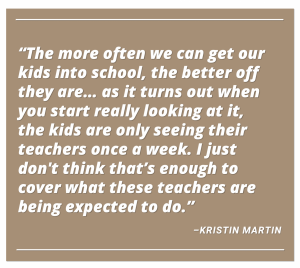 On the reopening of school and student wellness
On the reopening of school and student wellness
“I don’t think [students are] at school enough,” Martin said. At the Upper Saddle River Middle School she teaches at, kids can be kept in one class and go to school daily for instruction.
Martin pointed out that “when you start really looking at it, the kids are only seeing their teachers once a week.” This is somewhat accurate; depending on the schedule for that week, a student can see their teacher in person either once or twice.
She praised teachers for the “dynamic job” they are doing and said she thinks the district is “doing a nice job trying to get these teachers [into school] and making accommodations for those who cannot” through initiatives such as in-district daycare for teachers’ children and support for working from home.
“I am actually responsible for the sixth, seventh, and eighth-graders [at Upper Saddle River] who have decided by their parents, for whatever reason medical or [familial], to stay home and go remote,” Martin explained “It is very difficult for these students to learn the same way they would in school, so I do think that ideally, we want everyone back in school. But at this time, we really do need to be flexible.’
Read full response
JM: According to your Facebook campaign account, you are a teacher, correct?
KM: Yes, at Upper Saddle River.
JM: You’re also the parent of two Valley kids, and it’s safe to say you are familiar with hybrid instruction. Have these experiences shaped your candidacy for the Board, and is there anything you’re interested in changing with the current instructional plan?
KM: In light of the restrictions, Valley and Hills are doing an exceptionally well job at trying to get you guys back into the building in a safe way. Where I am in [Upper Saddle River] middle school, we can keep kids in one class. They’re there every single day for half a day, which is much better. The more often we can get our kids into school, the better off they are.
I wish we could get kids into school more, because as it turns out when you start really looking at it, the kids are only seeing their teachers once a week. I just don’t think that’s enough to cover what these teachers are being expected to do. The teachers are doing a dynamic job of putting up videos, and everybody has put in way more time than they’ve ever put in to make sure [students] have a very rich academic experience. I just hope we can get back to normal where [students] are in every day or at least more frequently. I don’t think [students are] at school enough.
Again, Martin said that “some kids are just spiraling out of control” as a result of what she called a “lockdown mentality” which “has wreaked havoc on our children’s welfare as far as mental health.”
While “lockdown” is now over, Martin argued that student wellness as a topic of Board discussion should remain at the forefront.
Read full response
JM: We all want to return to normal times as soon as possible. There are some parents and students concerned about their wellness; their mental health or safety. This is partially the result of there being some cases, in some New Jersey schools as they have reopened. There are also some teachers with lingering concerns. Do you understand their concerns?
KM: Regarding teachers, their concerns vary. Some of them have medical conditions or family members they care for with medical conditions. Valley and Hills have tried to accommodate teachers by allowing them to teach from home and providing childcare for teachers so that they can be at school as much as possible. I do think they’re doing a nice job trying to get these teachers there and making accommodations for those who cannot.
I do think that the fear is real. I do think as far as wellness, the whole kind of “lockdown mentality” has wreaked havoc on our children’s welfare as far as mental health. There’s a lot of statistics out there saying especially at [the high school] age, [students] are very good at hiding [their] feelings. So it’s a little bit harder to figure out when these kids are in distress. I think that’s what’s happening now: Some kids are just spiraling out of control, and I’m seeing that with my students.
I am actually responsible for the sixth, seventh, and eighth-graders who have decided by their parents, for whatever reason medical or familiar, to stay home and go remote. It is very difficult for these students to learn the same way they would in school, so I do think that ideally, we want everyone back in school. But at this time, we really do need to be flexible. Flexibility is going to be the key to getting us all through this together.
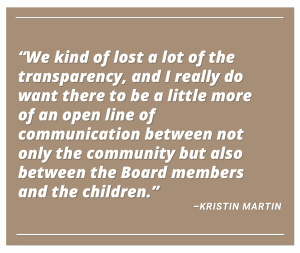
On the values she supports
Martin’s Facebook campaign account is titled “Supporting values in our schools – Vote for Kristin Martin for BOE.” When asked to specify which values she is referring to, Martin turned to the Board’s transparency –– something she argued was “kind of lost” in the mascot removal vote.
“I really do want there to be a little more of an open line of communication between not only the community but also between the Board members and the children,” Martin explained.
She praised students as “all very mature” and said they deserve to feel like “this is your school” when the Board makes impactful decisions.
Read full response
JM: Your Facebook campaign account is titled, “Supporting values in our schools – Vote for Kristin Martin for BOE.” What values are you referencing there and supporting as a candidate?
KM: We kind of lost a lot of the transparency, and I really do want there to be a little more of an open line of communication between not only the community but also between the Board members and the children. I think [students] are all very mature –– a lot are actually adults. The Board or the administration does not have to run everything through children, and I’m not saying that. I’m saying that it’s important that, when we make big decisions, we really do need to make sure we make people feel like this is your school. That you have a say, that you’re part of the decision making process. I know one of the questions you’re going to jump into is this Indian thing.
JM: [Sarcasm] How’d you know?
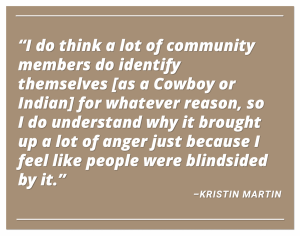 On the mascot removal
On the mascot removal
‘It’s the most important thing ever in the whole world,” Martin said sarcastically about the mascot removal, indicating that was not something she believed. She said she understands why community members who identified as a Cowboy or Indian feel “blindsided” by the Board’s unanimous vote.
She reminded voters that “this has been a conversation, and it’s not new,” but said “the timing was taken advantage of” and that “people are really not paying as much attention and these decisions were made.”
The mascots have been a topic of debate for over 20 years, and have been brought up for discussion at Board meetings numerous times before. At the June 25 Board meeting two days after the decision to remove them was made, over 500 people attended. At the original meeting, community members ranging from One Spirit Club members at Valley to parents at Hills spoke for over two hours.
More than anything else –– she would not “agree or disagree with the decision per se” –– Martin said she is disappointed in the anger in brought out. “I’ll tell you it was not the children –– it was more the adults,” she acknowledged, saying that if her freshman daughter was told she was now a Jaguar, “within a year or two she’s going to be all excited about Jaguars and won’t be looking for Indian clothing.”
Summarizing what her stance on the issue would be as a Board member, Martin said, “we need a fresh start… and we need to make decisions quickly so people can identify with this new mascot and move on.”
Read full response
KM: [Sarcasm] It’s the most important thing ever in the whole world. And I don’t agree with that. I did not grow up in Hillsdale; I grew up in Westwood, so it’s not like I grew up as an Indian or a Cowboy. I do think a lot of community members do identify themselves that way for whatever reason, so I do understand why it brought up a lot of anger just because I feel like people were blindsided by it.
As far as I can remember, this has been a conversation, and it’s not new. Just potentially, the timing was taken advantage of –– people are really not paying as much attention and these decisions were made.
I don’t agree or disagree with the decision per se. I disagree with the process. I think if we could avoid it and make the kids part of it… however, at this point I think we need to move on and pick a mascot quickly. Somebody called me up the other day and I said, “Honestly, the kids forget and move on.” They said, “I don’t think they ever will.” I responded, “Of course they will. My daughters are freshmen. If you tell her tomorrow she’s a Jaguar, and you get her a sweatshirt with ‘Jaguars’, within a year or two she’s gonna be all excited about Jaguars and won’t be looking for Indian clothing. So I do think it’s time we have to move on.
Really, with everything going on in our world, I’m really disappointed that this took so much time and effort and brought so much anger in our communities. I’ll tell you it was not the children –– it was more the adults. So I was really disappointed in the way some grown-ups were handling it. I think that we need a fresh start, we need to move on, and we need to make decisions quickly so people can identify with this new mascot and move on.

In terms of how she came to that perspective that a fresh start was the right decision, Martin referred to recently speaking “to someone who is actually a Native American[Indian].”
According to Martin, her Native American friend originally felt the Indian mascot was a “badge of honor’ but after research and speaking to local tribe leaders learned “that not everybody feels the same way she does.”
“If it’s going to make somebody uncomfortable, it’s not worth it,” Martin agreed. She did argue again that the process for their removal was flawed, and said if she was on the Board she would have “brought tribe leaders in and explained it to the children” and “it would have gone differently.”
Read full response
JM: Board member Arnold Scher said the following:
“No Board members that I have worked with –– when I came into the Board initially and the new ones that came on since –– come in with an agenda. They come in with one agenda: do right for the students and be right for the students. There’s no personal agenda or personal thing.
I think now, unfortunately, if you look at some of the people that are running [for the Board], they have a very simple agenda, and the agenda is to get on the Board and to use the mascot issue to rile up people to get themselves on the Board to then try to change the decision that was made and to bring back the mascots back into the system. And look at changing the curriculum and changing teachers and some administrative levels. This is because they unfortunately see progress as liberal or too liberal and don’t see that schools have to grow and change. I went to school at Valley in the 80s, late 70s, and it was a good school then. But if we stayed with those principles today, we would be the worst school in the state. So you have to continue to evolve and change and grow.”
Is this accurate or reflective of your motivation to run for the Board?
KM: I actually haven’t really heard a lot of talk [about the mascots] anymore. I absolutely do not think they should be going back to reinstating the Cowboys and Indians. At this point, they need to move forward.
I have actually spoken to people who have opinions on both sides, and I just recently spoke to someone who is actually a Native American. I was talking to her about her feelings, and she said, “Absolutely, initially, I found [that the Indian mascot] was a badge of honor, and I wore it proudly, and I was so sad when it was ripped away.” But then she went out and did some research of her own, found out some more information, and spoke to people who were tribe leaders today. They said that not everybody feels the same way she does, and she came back and she said, “You know what? I didn’t know everybody else’s perspective.”
That’s what we all need to start thinking about is that we need to look at perspective right now. If it’s going to make somebody uncomfortable, it’s not worth it. Everybody needs to be at school, they need to feel safe, they need to feel respected. If this mascot was making it that people didn’t feel that way, then we need to move on. It’s not that important.
We really need to value these children and their feelings, and again –– I’m very disappointed in the process. I feel like we missed out on this wonderful learning opportunity where if there were reasons like my friend has pointed out to me, and we could have brought tribe leaders in and explained it to the children, I think it would have gone differently. I understand the timing played a role in that, but again an educational institution owes the kids a little bit more.
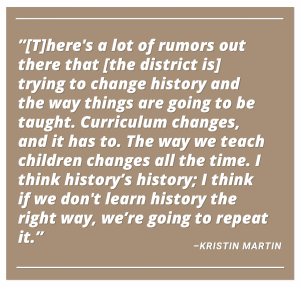
On the current district curriculum
Turning to curriculum, Martin spoke of her experience as a teacher. “Curriculum changes, and it has to,” she voiced. “The way we teach children changes all the time… if we don’t learn history the right way, we’re going to repeat it.”
Martin implied that the incorrect way to teach history is when “we don’t teach them to argue both sides respectfully and intelligently.”
Asked if she saw one-sided curriculum as a current issue or something to avoid, Martin said she “wants to avoid” it from being taught and that her children at Valley feel that “teachers respected both views regardless.”
“That’s the only way we’re going to grow,” she said.
Read full response
From what I’m understanding with the curriculum concerns, there’s a lot of rumors out there that [the district is] trying to change history and the way things are going to be taught. Curriculum changes, and it has to. The way we teach children changes all the time. I think history’s history; I think if we don’t learn history the right way, we’re going to repeat it. It’s very important we learn history, but I think what’s most important –– because high schoolers are intelligent and are able to see two sides –– is that the disservice we do is when we don’t teach them both sides. When we don’t teach them to argue both sides respectfully and intelligently. I think that’s what’s happening right now, people are just pulling onto a thought and they just can’t let it go. It’s not helping our children to see our adults behaving this way.
JM: Would you say the curriculum right now is inclusive of both sides? Is this a current problem or something you want to avoid?
KM: I definitely want to avoid it. I have to be honest, my son is a senior now at Valley, and I asked him, “Hey what do you think [about the curriculum]?”. He said for the most part, he really feels that teachers respected both views regardless. He never felt that people were leading, so I can only speak from that experience. My daughter is a freshman, and she hasn’t said anything, so I would hope that our educators in our school are able to teach children perspective and how to listen to both sides because that’s the only way we’re going to grow.
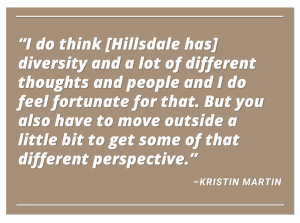 On inclusivity and equity
On inclusivity and equity
One of the district goals for this school year, like last year, is to “advance the work of inclusivity and equity throughout the district. Incorporating data-driven research into equity education for faculty, collaborative efforts with community and regional partners, curriculum development, and leadership and goal setting.”
Martin said her perspective on this goal originates from her children, who play club sports. “Not only did” the students her son played with “have different religions and spoke different languages, they definitely did not have what he had –– but they’re some of his best friends in the world.”
She said it helps to travel outside of the “Hillsdale bubble,” which she described as not a flaw in the town’s diversity, but something to be aware of since the factors that bring “[people here], they do have a common theme of being able to live a certain kind of life.”
Read full response
JM: One of the district goals for this school year is the following:
“Advance the work of inclusivity and equity throughout the district. Incorporating data-driven research into equity education for faculty, collaborative efforts with community and regional partners, curriculum development, and leadership and goal setting.”
You were previously a Hillsdale Football Association Board member and a youth sports coach. What have these experiences taught you about inclusivity and equity?
KM: That’s kind of my life experiences, I look through my children’s eyes, and it offers a better perspective. Both my children are on club teams, and I think they learned a lot more from those programs about inclusivity than they did in our own community, because although we might have diversity in religion and race and all that kind of stuff, we really do find that we’re in a community of very wealthy people. Whatever brings [people] here, they do have a common theme of being able to live a certain kind of life.
My son has been on club baseball for a very long time, and I think that’s given him an opportunity to meet children from areas who do not have that. Not only did they have different religions and spoke different languages, they definitely did not have what he had –– but they’re some of his best friends in the world.
People talk about the “Hillsdale bubble”, and I feel exceptionally proud that we have such a wonderful community, and I do think we have diversity and a lot of different thoughts and people and I do feel fortunate for that. But you also have to move outside a little bit to get some of that different perspective.
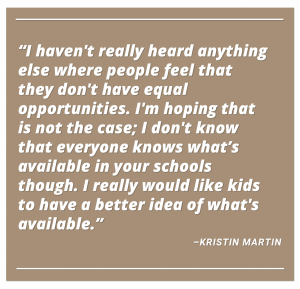
Martin said she was unsure if there are any practices in the district right now she thinks are inequitable or could be made more inclusive.
“I never heard that children do not feel welcome,” Martin observed, but said she “[doesn’t] think that everything is advertised the same” in terms of issues brought to the Board’s attention. One recent issue she said revolved around equity was when she heard “some questions about [female Valley athletes] wearing uniforms and” being required to have “the Indian [mascot] with black tape over it.”
While the mascots have been removed, there are no imminent plans to alter athletic uniforms until their purchasing cycle expires, and Superintendent Erik Gundersen recently said no student would be punished for wearing Cowboy or Indian gear.
“I haven’t really heard anything else where people feel that they don’t have equal opportunities. I’m hoping that is not the case,” Martin emphasized, but again stated she thinks students should “have a better idea of what’s available.”
She also said she would join any equity committee the Board creates if she is able to.
Read full response
JM: Are there any practices in the district right now that you think are inequitable or could be made more inclusive of different genders and/or races?
KM: That’s a great question and one I don’t know the answer to. I have never heard that children do not feel welcome. I don’t think that everything is advertised the same. I did hear that there were some questions about [some female Valley athletes] wearing uniforms and having the Indian with black tape over it, but I think that’s been solved. Apparently, they were given a directive from the athletic director that they would not be permitted to wear that. I think some of that kind of stuff has come out, but I haven’t really heard anything else where people feel that they don’t have equal opportunities. I’m hoping that is not the case; I don’t know that everyone knows what’s available in your schools though. I really would like kids to have a better idea of what’s available.
JM: There was an equity team created last year with students from both Hills and Valley, and they’ve also been working with teachers and administrators. They are also creating a committee on the Board called the equity committee. I don’t fully know the process of getting on that committee, but would you join it if you could?
KM: 100%.
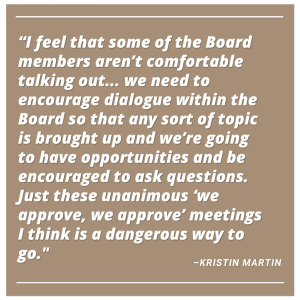 On Board members’ advocacy and responsibilities
On Board members’ advocacy and responsibilities
When asked if she is interested in working with Board members she might disagree with on any issue, Martin described the role as “not a blank check where you can do whatever you want” and that members must advocate for students and hold a responsibility to the community.
“I’m finding a lot of voting is just unanimous,” Martin said of Board votes, “because I feel that some of the Board members aren’t comfortable talking out.” Martin did not name a Board member or members in particular.
If elected, she said she would “encourage dialogue within the Board so that any sort of topic is brought up and we’re going to have opportunities and be encouraged to ask questions. Just these unanimous ‘we approve, we approve’ meetings I think is a dangerous way to go. “
Read full response
JM: You also said on your Board Facebook account that you want to foster “respectful dialogue.” I’ve also noticed that you have asked questions before at some recent Board meetings. Are you interested in working with Board members you disagree with? How would you make sure these conversations are respectful? Has being a Board member of the Hillsdale Football Association taught you how that is valuable?
KM: What needs to start to happen is that I’m finding a lot of voting is just unanimous because I feel that some of the Board members aren’t comfortable talking out. We even saw that with one of their reversals in a vote. So I think we need to encourage dialogue within the Board so that any sort of topic is brought up and we’re going to have opportunities and be encouraged to ask questions. Just these unanimous “we approve, we approve” meetings I think is a dangerous way to go.
JM: What kind of responsibilities do you think Board members have regarding advocacy regarding students or specific issues? Should they be more policymakers or issue advocates?
KM: The Board’s number one responsibility is to the children –– to be advocates for the children. I think also many will argue they’re supposed to be responsible to the community, whereas obviously, it’s not a blank check where you can do whatever you want. There are obviously some limits, but I think that our ultimate goal is to advocate for children. Their needs –– academically, socially, wellness –– all that has to come into play. So yes, I agree.
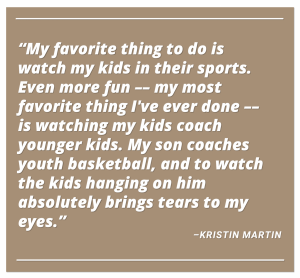 On her favorite pastime
On her favorite pastime
“My most favorite thing to do is watch my kids in their sports,” Martin said, but that her “most favorite thing” she has ever done “is watching my kids coach younger kids.”
Watching “kids hanging on” her son, who coaches youth basketball, brings tears to Martin’s eyes, she explained.
“When I see my kids giving back to their own community and me being able to watch them enjoy the school, the sports, and them growing up and being happy and looking at colleges and having all of these wonderful life experiences –– that’s what I like to do.”
Read full response
JM: Final question. Is there a pastime you really enjoy or something you really like to do outside of running for the Board?
KM: My favorite thing to do is watch my kids in their sports. Even more fun –– my most favorite thing I’ve ever done –– is watching my kids coach younger kids. My son coaches youth basketball, and to watch the kids hanging on him absolutely brings tears to my eyes. My daughter coaches the cheer in town. She’s done this going on four years. Those are the kind of things –– when I see my kids giving back to their own community and me being able to watch them enjoy the school, the sports, and them growing up and being happy and looking at colleges and having all of these wonderful life experiences –– that’s what I like to do. I obviously like to spend time with my neighbors and friends.
KM: Pat Luisi and I are running jointly. Pat Luisi and I started together, and we really have a lot of similar beliefs. We worked together on the Hillsdale Football Association Board for years. We have a really tight bond, and yes, we’d both like to be able to work together on the Board.
Read another profile:
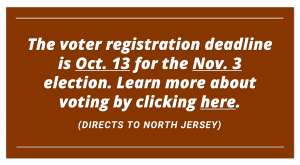

 Why Martin is running
Why Martin is running On the reopening of school and student wellness
On the reopening of school and student wellness
 On the mascot removal
On the mascot removal
 On inclusivity and equity
On inclusivity and equity
 On Board members’ advocacy and responsibilities
On Board members’ advocacy and responsibilities On her favorite pastime
On her favorite pastime